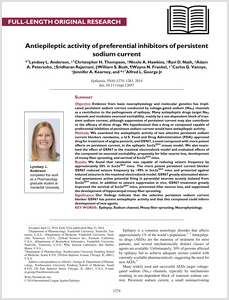Anderson LL, Thompson CH, Hawkins NA, Nath RD, Petersohn AA, Rajamani S, Bush WS, Frankel WN, Vanoye CG, Kearney JA, George AL,.
Evidence from basic neurophysiology and molecular genetics has implicated persistent sodium current conducted by voltage-gated sodium (NaV ) channels as a contributor to the pathogenesis of epilepsy. Many antiepileptic drugs target NaV channels and modulate neuronal excitability, mainly by a use-dependent block of transient sodium current, although suppression of persistent current may also contribute to the efficacy of these drugs. We hypothesized that a drug or compound capable of preferential inhibition of persistent sodium current would have antiepileptic activity.We examined the antiepileptic activity of two selective persistent sodium current blockers ranolazine, a U.S. Food and Drug Administration (FDA)-approved drug for treatment of angina pectoris, and GS967, a novel compound with more potent effects on persistent current, in the epileptic Scn2a(Q54) mouse model. We also examined the effect of GS967 in the maximal electroshock model and evaluated effects of the compound on neuronal excitability, propensity for hilar neuron loss, development of mossy fiber sprouting, and survival of Scn2a(Q54) mice.We found that ranolazine was capable of reducing seizure frequency by approximately 50% in Scn2a(Q54) mice. The more potent persistent current blocker GS967 reduced seizure frequency by 90% in Scn2a(Q54) mice and protected against induced seizures in the maximal electroshock model. GS967 greatly attenuated abnormal spontaneous action potential firing in pyramidal neurons acutely isolated from Scn2a(Q54) mice. In addition to seizure suppression in vivo, GS967 treatment greatly improved the survival of Scn2a(Q54) mice, prevented hilar neuron loss, and suppressed the development of hippocampal mossy fiber sprouting.Our findings indicate that the selective persistent sodium current blocker GS967 has potent antiepileptic activity and that this compound could inform development of new agents.

